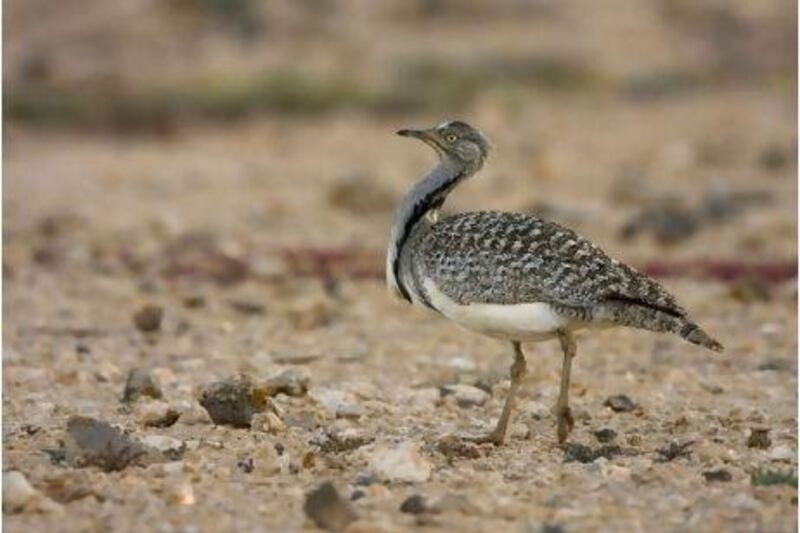DUBAI // Illegal hunters have shot and killed at least three houbara bustards, an endangered species threatened with extinction.
The birds had been bred in captivity and released in a protected area as part of efforts to re-establish the species after it was wiped out in the UAE. Hunters shot them after they flew out of the fenced-in zone.
MORE UAE NEWS: Our pick of today's top local news stories
Last Updated: June 21, 2011
Rule change to aid workers' mobility Educated workers in unskilled jobs will be able to move more easily to better posts. Read
Police confiscate dozens of jetskis after boy's death Push to impound illegal craft comes after boy dies in accident off Palm Jumeirah. Read article
Young man found dead in Porsche 'died of natural causes' Emirati Customs inspector found dead in his Porsche on Saturday died of natural causes, officials say. Read article
Pakistanis to send home record total for the year The Pakistan Embassy in Dubai says expatriates are sending a record amount of money home, due partly to banking improvements.Read article
[ MORE UAE NEWS ]
The houbara were among nearly 200 released last year at the Dubai Desert Conservation Reserve (DDCR), and were fitted with satellite tracking devices. When scientists realised they had died and went to recover the bodies, they discovered the birds had been shot.
The houbara is the traditional prey used by generations of Arab falconers. "I would have expected falconry to be the threat, but they were shot," said Greg Simkins, the reserve's conservation manager.
"It's illegal to hunt any bird or animal species in the country and it's very disappointing that it still happens, that people still don't see the benefit of having wildlife."
The houbara is listed by the Convention on International Trade in Endangered Species as threatened with extinction.
It died out in the UAE through falconry, hunting and habitat loss, and the country has been at the forefront of efforts to reintroduce it.
"We've had two releases of the houbara bustard in the reserve, one in February 2010 and the other at the end of December," Mr Simkins said. "In February, we released 29 and at the end of the year we released another 170."
Mr Simkins said only six of the original birds, and 20 from the second batch released, had satellite tracking, "so others could have been shot too".
In 2007, a pair released by the National Avian Research Centre (Narc), based at Sweihan, about 100km east of Abu Dhabi, became the first to breed in the wild here for decades.
The houbara releases at the Dubai reserve were carried out in partnership with Narc and Sheikh Mohammed bin Rashid's conservation team.
"When hindrances like this happen it's a great disappointment," Mr Simkins said. "The more houbaras that are surviving out there, the higher the chances of re-establishing the natural processes where they are breeding in the desert, which is the end goal of this project, and all these kinds of things are setbacks."
The Dubai houbara releases came about after a bird carrying satellite tracking was spotted inside the reserve. Mr Simkins photographed it and put the picture on the online nature forum uaebirding.com. Narc staff saw the photo and realised the bird was one they had released the previous year at a smaller protected site in Dubai.
"They came to the reserve and we realised this was a better area to release the birds. One, because it's larger so they're less likely to go over the fence and be threatened by hunting or any other danger, and also the vegetation is very good and there's a good insect population as well.
"Obviously, the houbara had come here for a reason, so they gave us a very good indication that this was a good area for them. So Narc suggested they did the next release here, which they did.
"We followed the six that had satellite tracking and saw that some left the reserve but they always tended to come back, and that was also a good indication that it was working well, that the houbara realised this was a good environment for them.
"They went as far as Oman, one went to Sweihan where they were bred and one went past Al Ain, but all of them came back."
The houbara are recorded in the reserve at irregular intervals, as they are so well camouflaged they are difficult to spot.
"I've been out tracking one and we narrowed it down to a small area and couldn't see it, it took us about 20 minutes to find it," Mr Simkins said.
"It was just sitting flat under a bush with its head down, perfectly camouflaged. So you can drive right past one without seeing it."
More positive signs were noted last week on a field trip, when Mr Simkins spotted seven birds - including three male-female pairs.
"We haven't found any clear indications of breeding yet - no eggs and no chicks. But we've seen signs of courtship displays and the pairs we saw last week are all good signs that they're inclined towards breeding."






